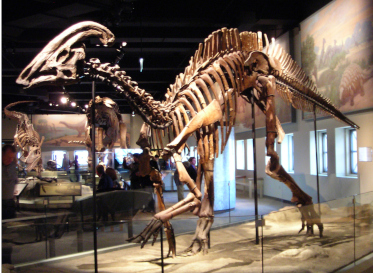No Explanation for Duck-Billed Evolution
Genesis 1:25
“And God made the beast of the earth after his kind, and cattle after their kind, and every thing that creepeth upon the earth after his kind: and God saw that it was good.”
 One of the most popular objects at the Mount St Helens Creation Center is a fossilized hadrosaur egg. Hadrosaurs were two-ton dinosaurs, which are often called duck-billed dinosaurs because their skulls show that they had an elongated mouth, looking like the bill of a duck. Their mouths were packed with a large number of tiny teeth, and this suggests to some scientists that they must have been herbivores, though this indication must be tempered by remembering that God originally made all creatures to eat plants. These dinosaurs also had bony crests, and some of these bones in the skull were hollow, leading some people to suggest that the animals could route air flows through these chambers, making trumpet-like sounds.
One of the most popular objects at the Mount St Helens Creation Center is a fossilized hadrosaur egg. Hadrosaurs were two-ton dinosaurs, which are often called duck-billed dinosaurs because their skulls show that they had an elongated mouth, looking like the bill of a duck. Their mouths were packed with a large number of tiny teeth, and this suggests to some scientists that they must have been herbivores, though this indication must be tempered by remembering that God originally made all creatures to eat plants. These dinosaurs also had bony crests, and some of these bones in the skull were hollow, leading some people to suggest that the animals could route air flows through these chambers, making trumpet-like sounds.
A recent study at the University of Bristol was researching how they thought the bone structures and feeding mechanisms of hadrosaurs could have evolved. The lead scientist said, “Our study shows that the unique hadrosaur feeding apparatus evolved fast in a single burst, and once established, showed very little change. In comparison, the elaborate display crests kept diversifying in several bursts of evolution, giving rise to the many weird and wonderful shapes.”
It is interesting to examine these comments. Evolutionists cannot find any evidence of gradual change in these structures, so, instead of concluding that they did not evolve, they have to suggest mysterious “single-burst” changes, which actually means there was no change noticed at all. God designed them, and the fossil evidence is consistent with that fact.
Prayer: In every avenue of science, we see Your handiwork, Father God, and we praise You for it. Amen.
Author: Paul F. Taylor
Ref: University of Bristol. “Chewing versus sex in duck-billed dinosaurs: Evolutionary bursts led to weird and wonderful head crests.” ScienceDaily, 2 May 2019. <www.sciencedaily.com/releases/2019/05/190502104822.htm>. Image: CC BY-SA 2.0 Generic.
Copyright © 2020 Creation Moments, Inc. All Rights Reserved